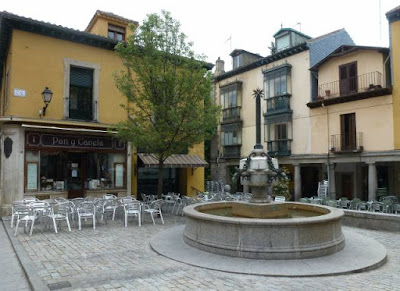Also the name of
world the world famous classical guitarist who died in 1987, this atmospheric
city is very much alive- with tourists visiting its three ‘A’ list attractions.
Top star is the
Roman aqueduct, acknowledged as the most impressive Roman structure in Spain.
It was built around end of the 1st century A.D. to carry water from
the Sierra Guadarrama mountains into Segovia. It’s the first thing we saw on
arrival.
Close-up it’s even
more intimidating. Nearly 100 feet tall, 170 arches, 25,000 stone blocks with
no mortar.
Climbing up the
pedestrian stairway into the old town you get to see these dry stone blocks close
up and its half mile length.
Below is the walled
town we’re about to explore. We ascended the steps but you could equally drive
up on this road. The town was walled by order of King Alphonso, he of Avila
fame, after he’d driven off the Moors.
At the top of the
steps is a lovely view of part of the city with the partially snow-capped
Guadarrama Mountains as background.
Into the old city now
and to mustvisit no.2, the cathedral. You’re perhaps all cathedralled out-
there’s been one in every recent blog- but this is a fine example and we won’t
spend too long on it. From the outside it’s a landmark sight, the last gothic
cathedral built in Spain.
The altar screen is
usually the most visually arresting point in cathedrals and here too it doesn’t
disappoint in its massed ornate gilded pillars and icons.
The altar
background carries on upwards to a ceiling of exquisite craftsmanship.
However it poses
the question whether a less glitzy treatment doesn’t result in a more powerful impression
of grace and beauty, as in this other altar setting. The proportions of the
arches, rib vaulting and the fine, neutral coloured carvings across the back window
are, I think, much more effective.
On display was a
selection of tools and pulleys used in the cathedral’s construction. It is
incredible to us today that these wonderful buildings were constructed with such
primitive tools, and how well they’ve endured.
Cathedral visit
over, we enter the busy streets to head for the Alcazar, our last major
attraction.
The Alcazar is a
medieval fortress, first documented in 1122 but probably there long before
that. It was a favourite residence for many Spanish monarchs. Substantially rebuilt in the original style
following a disastrous fire in 1862, it now houses military archives and the
Royal Artillery School museum. This is a view of the entrance which shows its
unusual design.
The structure is
partly hidden by the front towers and is larger than it appears from the photo.
It’s a typical castle introduction to start: knights in armour, although only
jousting armour we are told, not battle quality. Still somewhat heavier than
the average guy would want to wear to the office, methinks.
When they rebuilt
the castle they extended it but still left the original outer wall that then
became an inner wall. This now looks slightly odd now but does show the Moorish
influence on the old fortress’ design.
The Alcazar is full
of amazing ceilings, and the following photo is an example. The cathedrals we’ve
visited are just the same- magnificent, ornate ceilings, even in rooms with
plain walls. Why would you put so much time and money into decorating the part
of the room that’s least visible? Did they spend that much time lying flat on
their backs- maybe the drink was stronger then?
The armoury
displays medieval weapons like these next cannon. They have to be more of a
threat to the user than to the enemy.
On the forward
battlements the audio guide pointed out a feature in the mountains noted from
ancient times- the Sleeping Lady. Using your imagination, her face is side-view
on the left of the photo, her tummy in the middle. Reminded us of an acclaimed indisputable
likeness of Padre Pio on the side of a building in Italy. All we could see was
broken plaster.
The Alcazar was
built on a steep cliff, a strong defensive position. It was also surrounded by
a moat fed by encircling rivers. This gives an idea of its Impregnability and
it fact was never captured.
The artillery
museum was full of exhibits but needed too long to decipher to make a suitable
blog, so we walked through and had a general look just before leaving the
Alcazar. Back outside in the plaza, we look up and see several storks’ nests,
some with young. These are big birds and the nests huge and untidy. You certainly
wouldn’t want one on your chimney.
Back through
Segovia old town to the car park we pass many splendid buildings but no time
(or inclination at this stage) to pause to discover their history. An example
below.
An antiquity of an
entirely different type is visible in a private garage. It’s a vintage Rolls
Royce, with a UK number plate. The owner also looked more Brit than Spanish. The
internet tells me it’s a 1930 Phantom ll, sold about 2 years ago by a UK dealer
presumably to this chap. In the depths of the garage we noticed more Rolls
Royces. We didn’t have the nerve to approach the guy at the time for more info,
and of course later wished we had.
Car Park and back
to El Escorial campsite, 40 minutes. Segovia offered a varied day out that we thoroughly
enjoyed. Even the parking was easy although expensive.

























































